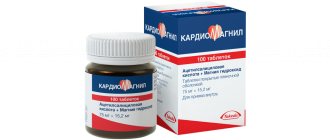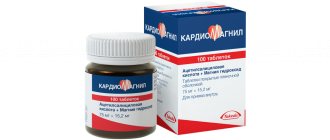Updated: 04/23/2021 15:12:57
Expert: Abramova Tsilya
Yarina is a hormonal drug that is used as a contraceptive and in the treatment of certain hormone-dependent diseases. The product is available in two versions - Yarina and I Yarina Plus. They differ in one component in their composition. We analyzed the tools to find out in which situations it is preferable to use one or the other.
| Means | Advantages | Flaws |
| Yarina | + Popular COC based on drospirenone and ethinyl estradiol + Helps with acne and seborrhea + Convenient administration – once a day for 3 weeks with a break of 7 days + Normalizes the menstrual cycle + Reduces pain during menstruation | — Many contraindications — Greater risk of adverse symptoms |
| Yarina Plus | + Additionally contains folic acid + Used after abortion + Suitable for women who are planning pregnancy after discontinuation of the drug + Replenishes vitamin B9 deficiency + Taken without interruption, which helps prevent missed doses | — More restrictions on admission - Many possible side effects |
Compound
- One active tablet of Yarina Plus contains 3 mg of drospirenone , 30 mcg of ethinyl estradiol , 451 mcg of calcium levomefolate . Additional substances: microcrystalline cellulose, lactose monohydrate, hyprolose, croscarmellose sodium, magnesium stearate, orange varnish.
- One vitamin supplement tablet of Yarina Plus contains 451 mcg of calcium levomefolate . Additional substances: microcrystalline cellulose, lactose monohydrate, hyprolose, croscarmellose sodium, magnesium stearate, light orange varnish.
Composition and characteristics
Release form: tablets. Each blister contains 21 active tablets and 7 tablets containing only vitamins (calcium levomefolate).
Active ingredients:
- Drospirenone (drospirenonum) – 3 mcg; has an antiandrogenic effect.
- Ethinyl estradiol (aethinyloestradiolum) – 30 mcg; analogue of endogenous estradiol.
- Calcium levomefolate (calcii levomefolinas) – 451 mcg; biologically active folic acid formula. This is a medicinal substance designed to eliminate folate deficiency in the female body.
Manufacturer: Bayer Schering Pharma AG (Germany).
Each package contains a detailed annotation about the composition, rules of administration (+ what to do if missed), indications, contraindications, side effects and absorption of the drug by the body.
How COCs work - read.
Pharmacodynamics and pharmacokinetics
Pharmacodynamics
Monophasic low-dose combined oral estrogen-progestin contraceptive drug, which includes active and auxiliary tablets with calcium levomefolate .
The contraceptive effect of Yarina Plus is carried out by suppressing ovulation and increasing the viscosity of cervical mucus. In patients taking such oral contraceptives, the cycle is normalized, pain, intensity and duration of bleeding are reduced, and as a result, the risk of iron deficiency anemia . There is also evidence of a decreased likelihood of endometrial and ovarian tumors.
Drospirenone exhibits an antimineralocorticoid effect and prevents fluid retention, which can reduce body weight and reduce the risk of peripheral edema. It has antiandrogenic activity and helps relieve acne , reduce oily hair and skin. These facts must be taken into account when choosing a contraceptive for women with hormonal fluid retention, as well as acne .
Calcium levomefolate is an active form of folate that is absorbed better than folic acid . Necessary to meet the increased need for folate during pregnancy and lactation. The presence of calcium levomefolate in the oral contraceptive reduces the likelihood of neural tube defects in the fetus if pregnancy occurs after discontinuation of contraception.
Pharmacokinetics
Drospirenone
After administration it is quickly absorbed. The highest level in the blood is reached after an hour and a half. Bioavailability is 76-85%. Binds to albumin and does not react with hormone binding globulin . Only 3-5% of the substance circulating in the blood is in free form. With systematic use of the drug, the concentration of drospirenone in the blood increases by 2-3 times. Most metabolites are represented by acid derivatives of drospirenone. Excreted through the kidneys and intestines.
Ethinyl estradiol
Rapidly absorbed after oral administration. The maximum level in the blood is reached after an hour and a half. Food reduces bioavailability by 25%. Ethinyl estradiol reacts actively with blood albumin. It is transformed in the liver by aromatic hydroxylation with the production of numerous metabolites. Excreted as metabolic in urine and feces. The half-life reaches 24 hours.
Calcium levomefolate
Rapidly absorbed after entering the digestive tract. In the form of L-5-methyl-THF, it is delivered to organs and peripheral tissues. Folates are involved in the biosynthesis of thymidine, purines, DNA, RNA, methionine and glycine . It is excreted mainly by the kidneys in its original form and in the form of metabolites.
Pharmacokinetics
Drospirenone
When taken orally, drospirenone is rapidly and almost completely absorbed. After a single oral dose, the serum Cmax of drospirenone, equal to 37 ng/ml, is achieved within 1–2 hours. Bioavailability ranges from 76 to 85%. Food intake does not affect the bioavailability of drospirenone.
Drospirenone binds to serum albumin (0.5–0.7%) and does not bind to sex hormone binding globulin (SHBG) or corticosteroid binding globulin (CBG). Only 3–5% of the total concentration in the blood serum is found in free form. The increase in SHBG induced by ethinyl estradiol does not affect the binding of drospirenone to plasma proteins.
After oral administration, drospirenone is completely metabolized.
Most metabolites in plasma are represented by acidic forms of drospirenone, which are formed without the involvement of cytochrome P450.
The concentration of drospirenone in blood plasma decreases in 2 phases. Drospirenone is not excreted unchanged. Drospirenone metabolites are excreted by the kidneys and intestines in a ratio of approximately 1.2–1.4. T1/2 for excretion of metabolites in urine and feces is approximately 40 hours.
During cyclic treatment, the maximum steady-state serum concentration of drospirenone is achieved in the second half of the cycle.
A further increase in the serum concentration of drosperinone is observed after 1–6 cycles of administration, after which no increase in concentration is observed.
Additional information for special categories of patients
Patients with liver disorders. In women with moderate liver dysfunction (class B on the Child-Pugh scale), AUC is comparable to the corresponding indicator in healthy women with similar Cmax values in the absorption and distribution phases. T1/2 of drospirenone in patients with moderate liver dysfunction was 1.8 times higher than in healthy volunteers with intact liver function.
In patients with moderate liver dysfunction, a 50% decrease in the clearance of drospirenone was observed compared with women with preserved liver function, while there were no differences in the concentration of potassium in the blood plasma in the studied groups. When diabetes mellitus is detected and concomitant use of spironolactone (both conditions are regarded as factors predisposing to the development of hyperkalemia), an increase in the concentration of potassium in the blood plasma has not been established.
It should be concluded that drospirenone is well tolerated in women with mild to moderate liver dysfunction (Child-Pugh class B).
Patients with kidney disorders. The concentration of drospirenone in the blood plasma when reaching a steady state was comparable in women with mild renal impairment (Cl creatinine - 50-80 ml/min) and in women with preserved renal function (Cl creatinine - > 80 ml/min). However, in women with moderate renal impairment (Cl creatinine 30–50 ml/min), the average plasma concentration of drospirenone was 37% higher than in patients with preserved renal function. Drospirenone was well tolerated by all groups of patients. There were no changes in the concentration of potassium in the blood plasma when using drospirenone.
Ethinyl estradiol
After oral administration, ethinyl estradiol is rapidly and completely absorbed. Cmax in blood plasma, equal to approximately 54–100 pg/ml, is achieved in 1–2 hours. During absorption and first passage through the liver, ethinyl estradiol is metabolized, resulting in its oral bioavailability, on average, about 45%.
Ethinyl estradiol is almost completely (approximately 98%), although nonspecifically, bound by albumin. Ethinyl estradiol induces the synthesis of SHBG.
Ethinyl estradiol undergoes presystemic conjugation, both in the mucous membrane of the small intestine and in the liver. The main route of metabolism is aromatic hydroxylation.
The decrease in the concentration of ethinyl estradiol in the blood plasma is biphasic. It is not excreted from the body unchanged. Metabolites of ethinyl estradiol are excreted in urine and bile in a ratio of 4:6 with T1/2 for about 24 hours.
Css is achieved during the second half of the cycle.
Contraindications
Taking the medication is contraindicated if any of the following diseases are present or appear while taking the medication:
- the presence of several or one pronounced risk factor for vascular thrombosis ;
- pre-thrombosis conditions in the past or present;
- thrombosis or thromboembolism in the past or present, cerebrovascular disorders;
- diabetes mellitus with concomitant vascular disorders;
- migraine with focal neurological symptoms in the past or present;
- liver failure or liver disease;
- liver tumors in the past or present;
- decompensated or acute renal failure;
- malignant hormone-dependent tumors or suspicion of their presence;
- lactation;
- pregnancy or possible but not confirmed pregnancy;
- hereditary lactose intolerance lactase or impaired absorption of glucose and galactose ;
- bleeding from the vagina of unknown origin;
- hypersensitivity to the components of the drug.
Take the drug with extreme caution if you have at least one of the following conditions:
- risk factors for thrombosis : obesity , smoking, dyslipoproteinemia, migraine, arterial hypertension , heart valve defects, hereditary thrombosis
- diseases that may cause peripheral circulatory disorders: diabetes mellitus, sickle cell anemia, hemolytic-uremic syndrome, systemic lupus erythematosus, Crohn's disease, phlebitis ;
- hypertriglyceridemia;
- angioedema of a hereditary nature;
- diseases that arose or intensified during pregnancy or against the background of the use of sex hormones ( cholelithiasis , jaundice due to cholestasis , otosclerosis, herpes of pregnant women, porphyria, Sydenham chorea );
- liver diseases not listed as contraindications;
- postpartum period.
Which drug to choose
Yarina is better suited as a contraceptive for healthy women who are not planning a pregnancy in the near future after stopping taking COCs.
Yarina + should be preferred by women who take COCs not only for contraception, but also for the treatment of acne. The drug is better suited if the birth of a child is planned in the near future. Yarina + is also taken for folic acid deficiency. It is also prescribed to women who have had an abortion.
Yarina can replace Yarina +. When it is initially advisable to take a second drug, then changing medications will be an irrational decision.
Before starting to take COCs, you should definitely consult your doctor. Hormonal drugs have many contraindications and a high risk of side effects.
Side effects
- Nervous disorders: migraine , headache .
- Mental disorders: changes in libido , depressed mood.
- Circulatory disorders: changes in blood pressure , thromboembolism .
- Respiratory disorders: bronchial asthma .
- Digestive disorders: abdominal pain, nausea, diarrhea , vomiting.
- Skin disorders: erythema multiforme, eczema, acne , rash, itching , erythema nodosum, urticaria .
- Visual disturbances: discomfort when wearing contact lenses.
- Hearing disorders: hypoacusia .
- Reproductive disorders: pain or enlargement of the mammary glands, vaginal candidiasis leucorrhoea , non-cyclic bleeding, changes in the menstrual cycle, vaginitis .
- Other disorders: weight changes, fluid retention, allergic reactions .
Severe side effects of Yarina Plus, which have been reported from people using combined oral contraceptives:
- thromboembolic venous and arterial disorders;
- cerebrovascular disorders;
- increased blood pressure;
- hypertriglyceridemia;
- hyperkalemia;
- impaired glucose tolerance ;
- changes in liver function indicators;
- liver tumors;
- angioedema in persons with a hereditary type of this disease;
- chloasma;
- the appearance or worsening of conditions arising from the use of oral combined contraceptives - jaundice, cholelithiasis, porphyria, herpes of pregnancy , hearing loss, Sydenham's chorea, systemic lupus erythematosus, hemolytic-uremic syndrome, Crohn's disease , cervical cancer .
Description of Yarina's product
Yarina is a hormonal tablet based on drospirenone and ethinyl estradiol. This is a combined oral contraceptive (COC), the composition of which has a similar profile to natural progesterone. The contraceptive effect is due to inhibition of ovulation and changes in cervical secretion. The drug is produced by Bayer, Germany.
Dispensed with a doctor's prescription. Release form: tablets of 21 pieces.
What are the contraindications
The drug should not be taken if there is a risk of arterial or venous thromboembolism. Yarina has other serious contraindications, so you can take the drug only after consulting a doctor.
You should not take COCs if you have the following risk factors:
- diabetes with complications;
- hypertension;
- dyslipoproteinemia;
- severe liver pathologies;
- kidney failure;
- hormone-dependent malignant tumors;
- bleeding of unknown etiology;
- intolerance to substances in the composition;
- suspicion of pregnancy or its confirmation.
The drug is not taken simultaneously with drugs that contain ritonavir, ambistavir, dasabuvir, paritaprevir. As for age restrictions, COCs should not be used before the onset of the first menstruation.
Side effects
Hormonal drugs often cause depressed mood, migraines, nausea, headaches, tenderness in the mammary glands, and vaginal discharge.
Severe side effects from taking COCs include:
- thromboembolic disorders;
- liver tumors;
- arterial hypertension;
- exacerbation of certain diseases - Crohn's disease, epilepsy, uterine fibroids;
- disruption of the hepatobiliary system;
- increased symptoms of angioedema.
Dosage schedule
The tablets are taken orally in the order indicated in the instructions. You need to take the medicine at the same time of day. The first dose occurs on the first day of the cycle. Prescribe 1 piece/day for 21 days. Afterwards you need a week's break, during which bleeding is observed. It occurs 2-3 days after taking the last tablet.
If a dose is missed by 12 hours, its contraceptive effectiveness is not reduced. The tablet should be taken as soon as possible. The next appointment will be at the usual time.
If you are more than 12 hours late and miss a dose, contraception is reduced. The medicine must be taken immediately. It is recommended to use barrier contraceptives for 7 days.
There is no information about drug overdose. Experience with the use of COCs shows that with a strong increase in dosage, nausea, vomiting, dyspepsia, and bleeding appear. The doctor prescribes symptomatic medications.
Who is it suitable for?
Yarina is a COC whose main purpose is to prevent unwanted pregnancy. Hormonal agents have positive properties that are used in the treatment of acne and seborrhea. The drug can be prescribed as part of complex therapy for hormone-dependent tumors. Yarina also normalizes the menstrual cycle.
Yarina Plus tablets, instructions for use (Method and dosage)
The tablets are taken orally in the order indicated on the package, at the same time every day, with water and without chewing.
Reception begins on the first day of the cycle (the first day of menstrual bleeding). Take one tablet per day continuously for 4 weeks. The use of tablets from the next pack begins immediately after the completion of the previous one.
If symptoms of vomiting or diarrhea occur within 5 hours after taking the medication, absorption of the active substance becomes ineffective. In the described case, it is necessary to use additional contraceptive measures.
Yarina Plus is not used during menopause.
The medicine is contraindicated for women with severe renal and liver dysfunction.
How to switch from Yarina to Yarina plus?
If you want to switch from Yarina to Yarina Plus (and vice versa), then it’s easy. Switching from birth control pills alone is possible after the end of the package.
You finish 21 Yarina tablets, take a break for 7 days, and on the eighth day you start drinking Yarina Plus.
ATTENTION! The package of Yarin Plus contains 28 tablets (21 active and 7 vitamin), so there is no break in taking it. As soon as you have taken all 28 tablets, the next day you immediately start drinking a new pack.
Interaction
The use of drugs that stimulate microsomal liver enzymes can lead to increased excretion of sex hormones. Similar medications include: barbiturates, Phenytoin, Primidone, Carbamazepine, Rifampicin and others.
Some antibiotics ( penicillins and tetracycline ) can reduce the concentration of ethinyl estradiol . During the period of use of drugs acting on microsomal liver enzymes, and another 4 weeks after their discontinuation, you must additionally use a barrier method of contraception.
During the use of antibiotics ( Rifampicin and Griseofulvin do not cause such a need) and for another week after their discontinuation, it is recommended to additionally use a barrier method of contraception.
A number of drugs lower blood folate of calcium levomefolate by blocking the enzyme dihydrofolate reductase ( Trimethoprim, Methotrexate, Triamterene and Sulfasalazine ), reducing folate ( Cholestyramine ) or through unknown mechanisms ( Phenobarbital, Carbamazepine, Primidone, Phenytoin, Valproic acid ).
Folates are capable of changing the pharmacokinetic parameters of antiepileptic drugs , Methotrexate, Pyrimethamine , which is accompanied by a decrease in the therapeutic effect of the latter.
special instructions
There is a proven connection between the use of contraceptives of the described type and an increased risk of vascular thrombosis , but these diseases develop rarely. The risk of venous thrombosis is greatest in the first 12 months of taking the drug. The overall likelihood of venous thrombosis in patients using combined low-dose oral contraceptives is approximately 2.5 times higher than in patients not using such drugs. Venous or arterial thrombosis can be life-threatening and cause death in approximately 1% of cases.
Venous thrombosis can manifest as main pulmonary embolism, deep vein thrombosis, and other disorders. Arterial thromboembolism can cause vascular occlusion, stroke or myocardial infarction .
The risk of developing such thrombosis increases:
- in smokers;
- with age;
- with lesions of the heart valves;
- in obese ;
- in the presence of a hereditary or acquired tendency to thrombosis ;
- for dyslipoproteinemia ;
- with prolonged immobilization, surgery, interventions on the lower extremities;
- for migraines ;
- for arterial hypertension ;
- with atrial fibrillation .
An increase in the frequency and severity of migraine may be grounds for immediate discontinuation of this drug.
In very rare cases, when using contraceptives of the described type, the appearance of benign, and even less often, malignant liver tumors .
If severe abdominal pain occurs, liver enlargement, or symptoms of intra-abdominal bleeding, the possibility of a neoplasm should be taken into account during differential diagnosis.
In patients with deteriorating kidney function and elevated levels of potassium in the blood, the possibility of developing hyperkalemia as a result of the use of drugs that lead to a slowdown in the excretion of potassium from the body.
In patients with hypertriglyceridemia, pancreatitis may increase when taking combined contraceptives .
If during the period of use of Yarina Plus a persistent increase in blood pressure is detected, the medicine should be discontinued and therapy for arterial hypertension . It is allowed to continue taking the drug if, thanks to antihypertensive therapy, the blood pressure level has returned to normal.
Liver dysfunction may require discontinuation of Yarin Plus until the corresponding functional indicators return to normal levels. The resulting cholestatic jaundice requires discontinuation of the drug.
Taking folate may mask vitamin B12 .
Taking Yarin Plus can influence the results of a number of laboratory tests: indicators of the adrenal glands, liver, thyroid gland, kidneys, the level of transport proteins, coagulation and fibrinolysis .
The effectiveness of the medicine may be reduced if the tablets are not taken regularly, vomiting or diarrhea due to drug interactions.
While using the drug, discharge or non-cyclic bleeding from the vagina may occur, especially during the first months of taking it. Based on this, evaluation of any non-cyclic bleeding is carried out after completion of the adaptation period, which lasts 3 cycles.
If you do not take the drug regularly and there are no 2 consecutive bleedings during the withdrawal period, pregnancy must be excluded.
Before using the product, it is necessary to collect the patient’s medical history, conduct a general examination, gynecological examination, cytological diagnostics, examination of the cervix, and exclude pregnancy.
Reviews from women (before and after 30 and 40 years)
“Yarina plus didn’t suit me. I only took 9 tablets and had to cancel the appointment. I had severe weakness, dizziness, and then severe pain in the pancreas and in the heart area began. “In the end, I was prescribed a different drug.”
“I took Yarina Plus as prescribed by a doctor for the complex treatment of a corpus luteum cyst after the main treatment. There were no side effects, just none at all. And most importantly, after taking it for three months, I became pregnant without any problems. The child is healthy. We are happy".
“The first two months of taking everything was ok. but in the third month the condition began to deteriorate. There was profuse bleeding. Every day. I had to refuse the appointment.”
“Good drug. It was prescribed to me because of problems with my cycle. The only side effects were nausea and mood swings. After three months of taking it, the cycle returned to normal and the drug was discontinued. Now everything is fine, I’m healthy.”
“I took Yarina Plus for about a year. Prescribed for acne. Improvements began after two months of taking it. The downside is decreased libido.”
“A good drug Yarina plus. It helped me with acne and excess weight. Everything was back to normal. However, it doesn't suit my friend. Therefore, girls, everything is individual. If you want to take OK, go see a good specialist, get examined and get tested.”
Analogs
Level 4 ATC code matches:
Ovidon
Rigevidon
Non-Ovlon
Mercilon
Yarina
Miniziston 20 fem
Novinet
Microgynon
Janine
Lindineth
Cyclo-Proginova
Regulon
Logest
Midiana
Belara
Femoden
Jess Plus
Jess
Zoely
The closest analogue of the described product is a drug called Jazz Plus .
Reviews about Yarina Plus
Reviews about Yarina Plus on forums are generally positive. Of the associated effects, the most often noted is the appearance or elimination of acne , deterioration or improvement in the condition of hair and nails. Based on the reports of patients, we can say that unplanned pregnancy does not occur if the rules of administration are followed.
Reviews from doctors focus on the presence of calcium levomefolate , which reduces the likelihood of fetal development defects if pregnancy occurs after discontinuation of Yarina Plus.
Use during pregnancy and breastfeeding
The drug is not prescribed during pregnancy and breastfeeding. If pregnancy is detected while taking Yarina®, it should be discontinued immediately. However, extensive epidemiological studies have not revealed an increased risk of developmental defects in children born to women who received sex hormones before pregnancy or teratogenic effects in cases of inadvertent use of sex hormones in early pregnancy. At the same time, data on the results of taking Yarina® during pregnancy are limited, which does not allow us to draw any conclusions about the negative impact of the drug on pregnancy, the health of the newborn and the fetus. Currently, no significant epidemiological data are available.
Taking combined oral contraceptives may reduce the amount of breast milk and change its composition, so their use is not recommended until you stop breastfeeding. Small amounts of sex steroids and/or their metabolites may be excreted in milk.
Yarina Plus price, where to buy
The price of Yarina Plus in Russian pharmacies averages 890-940 rubles for package No. 28.
In Ukraine, a similar form of release will cost 250-320 hryvnia, depending on the region.
- Online pharmacies in RussiaRussia
- Online pharmacies in UkraineUkraine
ZdravCity
- Yarina plus tab.
p.p.o. 3mg+0.03mg+0.451mg n28 Bayer Weimar/Bayer Pharma RUB 1,192 order - Yarina plus tab. p.p.o. 3mg+0.03mg+0.451mg n84 Bayer Weimar/Bayer Pharma
2970 rub. order
Pharmacy Dialogue
- Yarina plus (table p/o No. 28x3) Bayer
RUB 2,956 order
- Yarina plus (tab. No. 28) Bayer
1200 rub. order
- Yarina plus (tab. No. 28) Bayer
RUB 1,123 order
show more
Pharmacy24
- Yarina plus N28 tablets - 3 packs Promotion of Bayer Pharma AG, Nimecchina/Bayer Weimar GmbH i Co.
KG, Nimechchyna 631 UAH.order - Yarina plus No. 28 tablets Bayer Pharma AG, Nimechchina/Bayer Weimar GmbH i Co. KG, Nimechchyna
261 UAH. order








